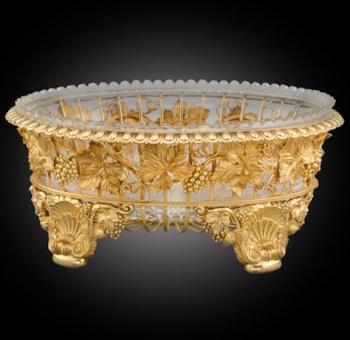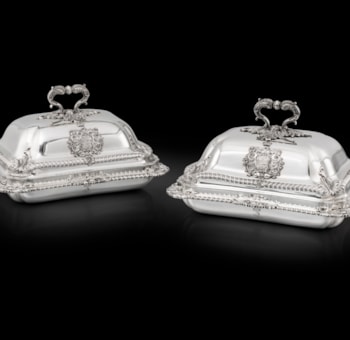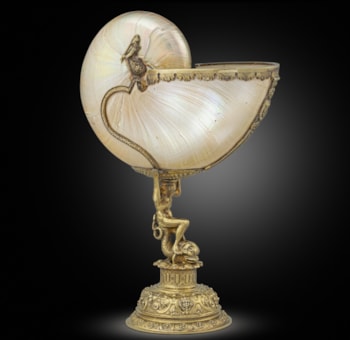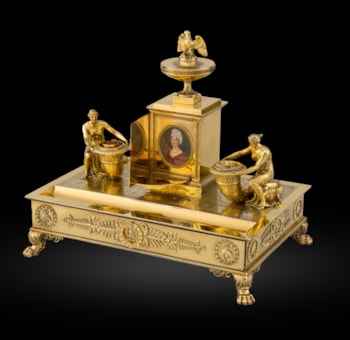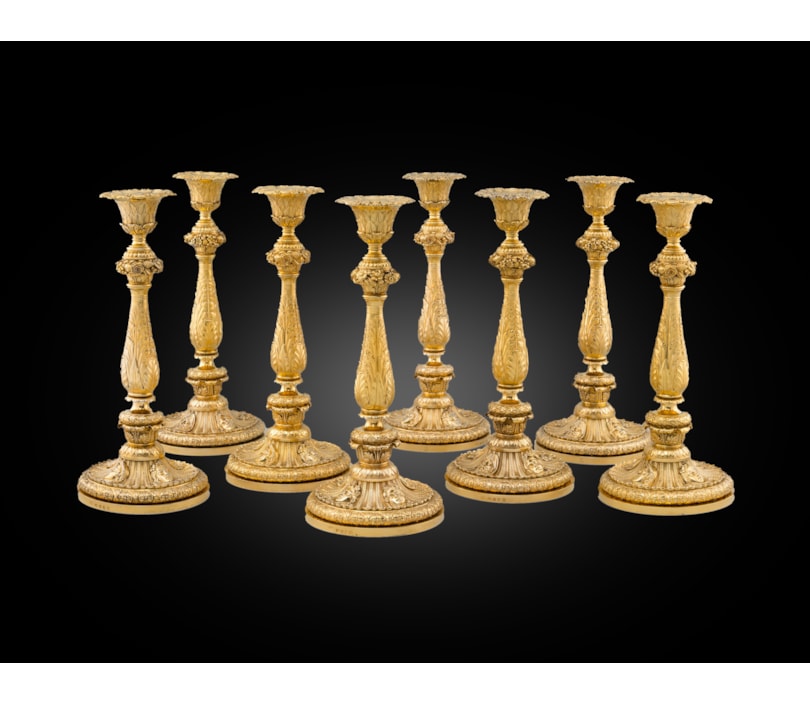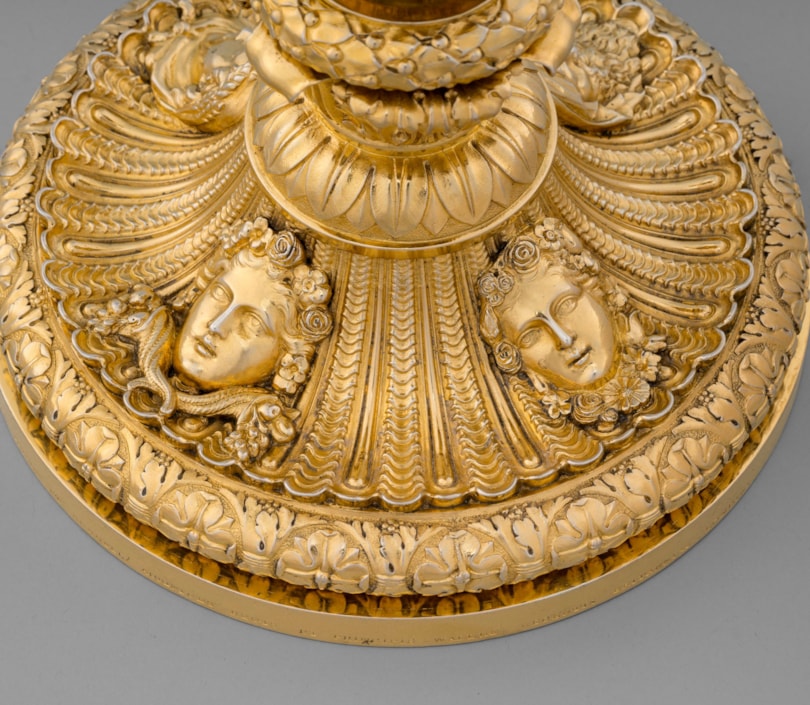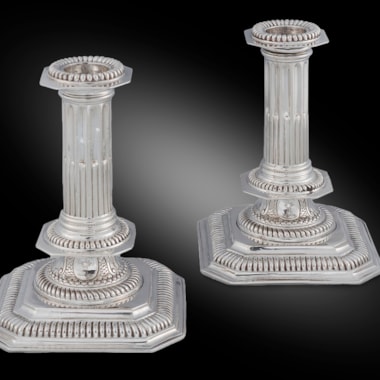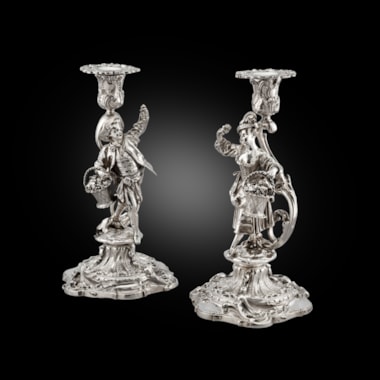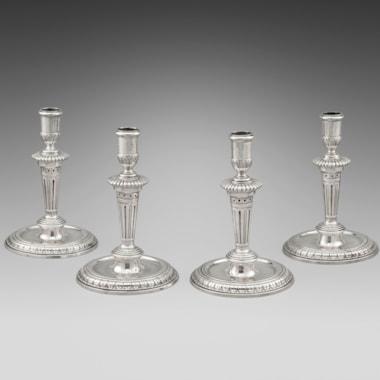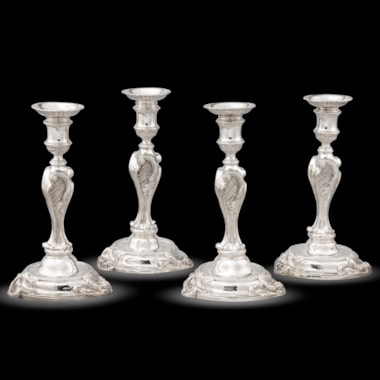These are the only set of eight candlesticks known to exist by Paul Storr. They are also among the largest and most ambitious candlesticks made in Britain in the 19th century. Another instance of Storr doing his very best work on behalf of Rundell's, they are in superb condition, with crisp decoration and brilliant gilding, and amongst the finest examples of Paul Storr's work anywhere in the world. The double crests are those of Watson-Taylor for George and Anna Watson-Taylor.
George Watson (1771-1841) was a Jamaican planter. He married Anna, the daughter of Sir John Taylor, likewise a Jamaican planter. Anna's uncle was Sir Simon Taylor, yet another Jamaican planter. Certainly the richest man in Jamaica, he was also probably the richest man in the realm. George and Anna were living an unremarkable life in London, when her uncle and brother died in quick succession, and Anna inherited Simon's entire fortune.
They had an income said to be between sixty and ninety thousand pounds a year and were among the richest people in England. They built fabulous collections in art, objects of vertu, books, furniture, and silver. They held lavish parties in their houses with no thought to the future, until the future caught up with them.
Despite Watson-Taylor's opposition as a member of parliament, the anti-slavery movement won major legislative victories, and the new laws decimated the income from his plantations. They were nearly broke by 1822, and so came the first of many sales. They were bankrupt in 1832, when the last of the collection was dispersed. Watson-Taylor died forgotten in Edinburgh in 1841. “No man“ Sir Robert Peel said of him “ever bought ridicule at so high a price."
These candlesticks were sold at one of these auctions, and their second home was nearly as wild a ride as the first. Whether bought at the sale by Rundell, Bridge & Rundell, and sold to her, or whether bought by her directly, they went to the collection of Harriet Beauclerk, the Duchess of St. Albans, whose collection of Paul Storr silver was both vast and exceptionally good.
Hers is a wonderful story of rags to riches. Harriet had been an exceptionally attractive child actress. At fourteen, she had caught the eye of Thomas Coutts, banker to the Royal family. When Coutts's wife died, he married Harriet, and they remained happily married until his death in 1822. Years later, she, having reached the age of 49, married the Duke of St. Albans, who was 26, and, for a Duke anyway, poor as a church mouse. She died, and the marriage having been childless, the whole of her estate, including these candlesticks, went to her step-granddaughter Angela Burdett-Coutts, whose initials and coronet are also engraved on the bases of the sticks. The last time these candlesticks were on the market was at the Coutts Heirlooms sale at Christie's in 1920.
George Watson-Taylor (1771-1841), probably sold at his auction in 1832, presumably purchased by Harriet Beauclerk (1777-1837), Duchess of St. Albans; thence to her stepdaughter Angela Burdett-Coutts (1814-1906) Sale, The Coutts Heirlooms, Christie's, 17 March 1920, lot 109
Son of Thomas Storr of Westminster, first silver-chaser later innkeeper, born 1771. Apprenticed c'1785. Before his first partnership with William Frisbee in 1792 he worked at Church Street, Soho, which was the address of Andrew Fogelberg. This is also the address at which Storr's first separate mark is also entered. First mark entered as plateworker, in partnership with William Frisbee, 2 May 1792. Address: 5 Cock Lane, Snow Hill. Second mark alone, 12 January 1793. Address: 30 Church Street, Soho. Third mark, 27 April 1793. Fourth 8 August 1794. Moved to 20 Air Street, 8 October 1796, (where Thomas Pitts had worked till 1793). Fifth mark, 29 November 1799. Sixth, 21 August 1807. Address 53 Dean Street, Soho. Seventh, 10 February 1808. Ninth, 21 October 1813. Tenth, 12 September 1817. Moved to Harrison Street, Gray's Inn Road, 4 March 1819, after severing his connection with Rundell, Bridge and Rundell. Eleventh mark, 2 September 1883. Address: 17 Harrison Street. Twelfth and last mark, 2 September 1833. Heal records him in partnership with Frisbee and alone at Cock Lane in 1792, and at the other addresses and dates above, except Harrison Street. Storr married in 1801, Elizabeth Susanna Beyer of the Saxon family of piano and organ builders of Compton Street, by whom he had ten children. He retired in 1838, to live in Hill House in Tooting. He died 18 March 1844 and is buried in Tooting Churchyard. His will, proved 3 April 1844, shows an estate of £3000. A memorial to him in Otely Church, Suffolk was put up by his son Francis the then incumbent of the parish. For full details of Storr's relationship with Rundell, Bridge and Rundell please see N.M. Penzer, 1954 or Royal Goldsmiths, The Art of Rundell and Bridge, 2005.
Storr's reputation rests on his mastery of the grandoise neo-Classical style developed in the Regency period. His early pieces up to about 1800 show restrained taste, although by 1797 he had produced the remarkable gold font for the Duke of Portland. Here, however the modelling of the classical figures must presumably have been the work of a professional sculptor, as yet unidentified, and many of the pieces produced by him for Rundell and Bridge in the Royal Collection must have sprung from designs commissioned by that firm rather than from his own invention. On the other hand, they still existed in his Harrison Street workshop, until destroyed in World War II, a group of Piranesi engravings of classical vases and monuments bearing his signature, presumably used as source material for designs. The massiveness of the best of his compositions is well shown in the fine urn of 1800 at Woborn Abbey, but the Theocritus Cup in the Royal Collection must be essentially ascribed to the restraint of its designer John Flaxman, while not denying to Storr its superb execution. Lord Spencer's ice pails of 1817 show similar quality. Not all Storr's work however was of classical inspiration. The candelabra of 1807 at Woburn derive from candlesticks by Paul Crespin of the George II period, formerly part of the Bedford Collection, and he attempted essays in floral rococo design from time to time, which tend to over-floridity. On occasions the excellence of his technical qualities was marred by a lack of good proportions, as in the chalices of the church plate of St Pancras, 1821. In spite of these small lapses there is no doubt that Storr rose to the demands made upon him as the author of more fine display plate than any other English goldsmith, including Paul De Lamerie, was ever called upon to produce.
You May Also Like







